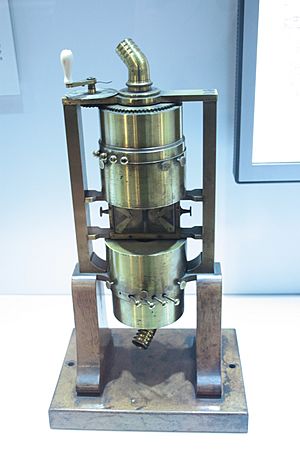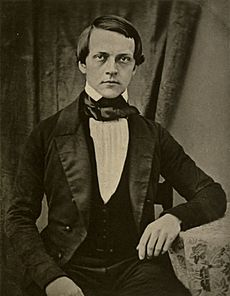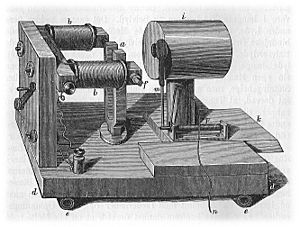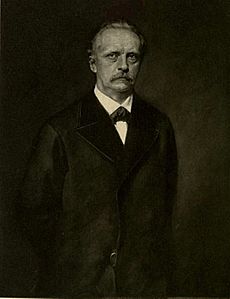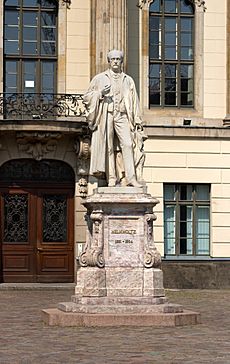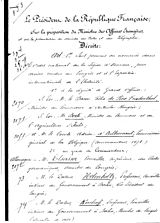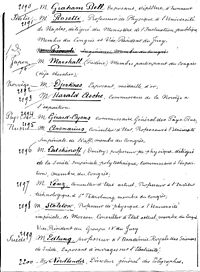Hermann von Helmholtz facts for kids
Quick facts for kids
Hermann von Helmholtz
|
|
|---|---|
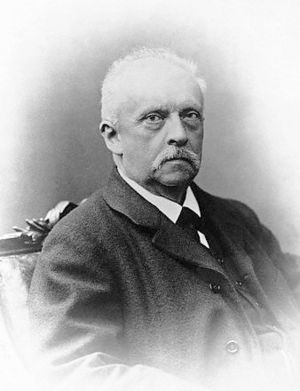 |
|
| Born |
Hermann Ludwig Ferdinand Helmholtz
31 August 1821 |
| Died | 8 September 1894 (aged 73) |
| Education | Medicinisch-chirurgisches Friedrich-Wilhelm-Institut (M.D., 1842) |
| Known for |
Studies in the conservation of energy
Helmholtz coil Helmholtz condition Helmholtz decomposition Helmholtz equation Helmholtz free energy Helmholtz free entropy Helmholtz layer Helmholtz pitch notation Helmholtz reciprocity Helmholtz resonance Helmholtz temperament Helmholtz classical theorem Helmholtz's theorems Helmholtz minimum dissipation theorem Generalized Helmholtz theorem Gibbs–Helmholtz equation Helmholtz-Ellis notation Helmholtz–Kohlrausch effect Helmholtz-Smoluchowski eqn. Helmholtz–Thévenin theorem Kelvin–Helmholtz instability Kelvin–Helmholtz mechanism Young–Helmholtz theory Smith-Helmholtz invariant Additive synthesis Efference copy Heat death paradox Hydrodynamic stability Keratometer Ophthalmoscopy Place theory Prism adaptation Pure tone Entoptic phenomenon Supercapacitor Vortex ring |
| Spouse(s) |
Anna von Mohl
(m. 1861) |
| Children | 3 |
| Relatives | Anna Augusta Von Helmholtz-Phelan (grand-niece) |
| Awards |
|
| Scientific career | |
| Fields | |
| Institutions |
|
| Thesis | De fabrica systematis nervosi evertebratorum (1842) |
| Doctoral advisor | Johannes Peter Müller |
| Doctoral students | |
| Other notable students |
|
| Influences | |
| Influenced | Friedrich Albert Lange Ludwig Wittgenstein |
Hermann Ludwig Ferdinand von Helmholtz (31 August 1821 – 8 September 1894) was a brilliant German scientist. He was a physicist and a physician. Helmholtz made huge discoveries in many areas of science. These included how our eyes and ears work, and the laws of energy.
He was so important that the Helmholtz Association is named after him. This is the biggest group of research institutions in Germany!
Contents
Biography
Early Life and Education
Hermann Helmholtz was born in Potsdam, Germany, in 1821. His father was a school headmaster who loved old languages and philosophy. Young Hermann was very interested in science.
Even though he loved science, his father wanted him to study medicine. So, Helmholtz went to medical school. He earned his medical degree in 1842. He then worked for a year at a hospital called Charité.
Even though he trained in medicine, Helmholtz wrote about many other topics. These included physics, the age of the Earth, and how the Solar System began.
University Career
Helmholtz started teaching anatomy in Berlin in 1848. He then became a professor of physiology at the University of Königsberg in 1849.
Later, he moved to the University of Bonn in 1855. He wasn't very happy there, so he moved again three years later. This time, he went to the University of Heidelberg.
In 1871, he took his last university job. He became a professor of physics at the Humboldt University in Berlin.
Amazing Discoveries
Understanding Energy
One of Helmholtz's first big scientific achievements was in 1847. He wrote about the conservation of energy. This idea means that energy cannot be created or destroyed. It can only change from one form to another.
He studied how our muscles use energy. He wanted to show that muscles don't lose energy. This helped prove that there wasn't some special "life force" making muscles move.
Helmholtz showed how mechanics, heat, light, electricity, and magnetism are all connected. He said they were different forms of the same "force," which we now call energy. He wrote about these ideas in his book On the Conservation of Force.
He also helped popularize the idea of the heat death of the universe. This theory suggests that eventually, the universe will run out of usable energy.
In the study of how liquids and gases move, called fluid dynamics, Helmholtz also made important discoveries. He developed Helmholtz's theorems about how vortexes (like whirlpools) behave in fluids.
How We See and Hear
Helmholtz was a pioneer in studying how humans see and hear. He was interested in how physical things (like sound waves) relate to what we actually experience.
For example, if you make a sound louder, it doesn't feel like it gets louder at the same rate. Helmholtz studied these connections. He wanted to create "psychophysical laws" to explain them.
His work on how we sense things influenced Wilhelm Wundt. Wundt was one of Helmholtz's students. He is known as one of the founders of experimental psychology.
Eye and Vision Research
In 1851, Helmholtz changed the field of ophthalmology forever. He invented the ophthalmoscope. This amazing tool lets doctors look inside the human eye. This invention made him famous very quickly.
He wrote a major book called Handbook of Physiological Optics. It explained his ideas on depth perception (how we see how far away things are). It also covered color vision and motion perception (how we see things moving). This book became super important in the field for many years.
In his book, Helmholtz also talked about "unconscious inferences." This means our brain makes quick, automatic guesses about what we see.
Nerve Signals
In 1849, Helmholtz measured how fast signals travel along a nerve. Before this, most people thought nerve signals were too fast to measure.
He used a frog's nerve and muscle. He found that nerve signals travel at about 24.6 to 38.4 meters per second. That's pretty fast, but not instant!
Sound and Music
In 1863, Helmholtz published a book called Sensations of Tone. This book showed his interest in the physics of sound and how we hear it. It greatly influenced music experts.
He invented the Helmholtz resonator. This device helps find the different frequencies (or pitches) in complex sounds. Think of it like breaking down a musical chord into its individual notes.
Helmholtz showed that combining different resonators could create vowel sounds. This inspired Alexander Graham Bell, who later invented the telephone. Bell misunderstood some of Helmholtz's diagrams, but it still pushed him to explore new ideas.
Electromagnetism Studies
In 1871, Helmholtz became a physics professor in Berlin. He became very interested in electromagnetism. The Helmholtz equation is named after him.
While he didn't make huge discoveries in this area himself, his student Heinrich Rudolf Hertz did. Hertz became famous for being the first to show electromagnetic radiation (like radio waves).
Students and Colleagues
Many famous scientists studied or worked with Helmholtz in Berlin. These included Max Planck, Heinrich Hertz, and Albert A. Michelson. These students went on to make their own important discoveries.
Honours and Legacy
Hermann von Helmholtz received many awards and honors for his work:
- In 1873, he became a member of the American Philosophical Society.
- He was made an Honorary Fellow of the Royal College of Surgeons in Ireland in 1881.
- In 1881, he received the Légion d'honneur from France. This is a very high award.
- In 1883, the Emperor honored him by making him a nobleman. This meant he and his family could use "von Helmholtz" in their name.
- The largest German association of research institutions, the Helmholtz Association, is named after him.
- An asteroid (11573 Helmholtz) and craters on the Moon (Helmholtz) and Mars (Helmholtz) are named in his honor.
- A street in Berlin, Helmholtzstraße, is also named after him.
Works
- (in de) Über die Erhaltung der Kraft. Leipzig: Wilhelm Engelmann. 1889. https://gutenberg.beic.it/webclient/DeliveryManager?pid=6555455.
- (in de) Vorlesungen über die elektromagnetische Theorie des Lichts. Leipzig: Johann Ambrosius Barth. 1897. https://gutenberg.beic.it/webclient/DeliveryManager?pid=6723936.
- (in de) Vorlesungen über die mathematischen Principien der Akustik. Leipzig: Johann Ambrosius Barth. 1898. https://gutenberg.beic.it/webclient/DeliveryManager?pid=6725127.
- (in de) Vorlesungen über die Dynamik discreter Massenpunkte. Leipzig: Johann Ambrosius Barth. 1898. https://gutenberg.beic.it/webclient/DeliveryManager?pid=6725946.
- (in de) Dynamik continuirlich verbreiteter Massen. Leipzig: Johann Ambrosius Barth. 1902. https://gutenberg.beic.it/webclient/DeliveryManager?pid=6727137.
- (in de) Vorlesungen über die Theorie der Wärme. Leipzig: Johann Ambrosius Barth. 1903. https://gutenberg.beic.it/webclient/DeliveryManager?pid=7174058.
Translated works
- On the Conservation of Force (1847) HathiTrust
- (in fr) Lehre von den Tonempfindungen als physiologische Grundlage für die Theorie der Musik. Paris: Masson. 1874. https://gutenberg.beic.it/webclient/DeliveryManager?pid=6723591.
- Helmholtz, Herman (1876). "On the Limits of the Optical Capacity of the Microscope". Monthly Microscopical Journal 16: 15–39. doi:10.1111/j.1365-2818.1876.tb05606.x. https://books.google.com/books?id=-DE4AAAAMAAJ&q=optics%20limit%20abbe%20fripp&pg=PA15.
- (in en) Populäre wissenschaftliche Vorträge. New York: Appleton. 1885. https://gutenberg.beic.it/webclient/DeliveryManager?pid=10984881.
- On the Conservation of Force (1895) Introduction to a Series of Lectures Delivered at Carlsruhe in the Winter of 1862–1863, English translation
- On the Sensations of Tone as a Physiological Basis for the Theory of Music (downloadable from California Digital Library) Third Edition of English Translation, based on Fourth German Edition of 1877, By Hermann von Helmholtz, Alexander John Ellis, Published by Longmans, Green, 1895, 576 pages
- On the Sensations of Tone as a Physiological Basis for the Theory of Music (downloadable from Google Books) Fourth Edition, By Hermann von Helmholtz, Alexander John Ellis, Published by Longmans, Green, 1912, 575 pages
- Treatise on Physiological Optics (1910) three volumes. English translation by Optical Society of America (1924–25).
- Popular lectures on scientific subjects (1885)
- Popular lectures on scientific subjects second series (1908)
See also
 In Spanish: Hermann von Helmholtz para niños
In Spanish: Hermann von Helmholtz para niños
- Helmholtz coil
- List of people from Berlin
- List of things named after Hermann von Helmholtz
- Neo-Kantianism
- Theory of Colours


